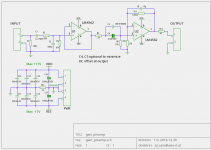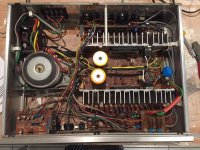I have a 1980ies Dual CV 1450 integrated amplifier whom I like design-wise. Unfortunately one of it's Sanyo STK-086G thick film hybrid power modules has passed recently. Even more unfortunately, they're unobtanium nowadays, most probably due to Sanyo's dismission of their semiconductor section.
Of course power packs called STK-086G still are offered on eBay. But what would I get really? As it's sibling STK-086 still can be sourced form reliable vendors such as Mouser, but offer more than four times of THD in comparison, I'm afraid that the eBay vendors just offer relabeled (= fake) STK-086's.
In the amplifier design (SM here: DUAL CV1450 Service Manual download, schematics, eeprom, repair info for electronics experts) almost any line signal amplification is done in these power packs, which are set to a gain of 57 (= 35 dB). Replacing them by real chip amps, as e.g. LM3886's, is excluded by their limited gbw product, which doesn't leave too much HF rolloff when set to a gain of 35 dB. On top of that their small package might induce thermal problems when installed to the given heatsinks.
So I'm considering to go discrete. Which high quality amplifier would you advise me to build that runs on +/- 30 V rails (+/- 36 V at idle) and drives 4 ohms?
Of course I know that I'd need another, or additional, PCB's .
.
Best regards!
Of course power packs called STK-086G still are offered on eBay. But what would I get really? As it's sibling STK-086 still can be sourced form reliable vendors such as Mouser, but offer more than four times of THD in comparison, I'm afraid that the eBay vendors just offer relabeled (= fake) STK-086's.
In the amplifier design (SM here: DUAL CV1450 Service Manual download, schematics, eeprom, repair info for electronics experts) almost any line signal amplification is done in these power packs, which are set to a gain of 57 (= 35 dB). Replacing them by real chip amps, as e.g. LM3886's, is excluded by their limited gbw product, which doesn't leave too much HF rolloff when set to a gain of 35 dB. On top of that their small package might induce thermal problems when installed to the given heatsinks.
So I'm considering to go discrete. Which high quality amplifier would you advise me to build that runs on +/- 30 V rails (+/- 36 V at idle) and drives 4 ohms?
Of course I know that I'd need another, or additional, PCB's
Best regards!
Last edited:
I do not believe the LM3886 at gain of 57 will be markedly inferior to the Sanken.
There's no simpler fix possible. '3886 kits readily available from the orient, probably-good LM3886 and minor parts still available from reputable suppliers.
If the slight change bothers you, build an opamp gain-of-2.8 stage and put it in front.
I am mildly worried that you would be very close to the LM3886's ratings, and you already killed a Sanken. Are the heatsinks big enough? Are your loads ugly?
There's no simpler fix possible. '3886 kits readily available from the orient, probably-good LM3886 and minor parts still available from reputable suppliers.
If the slight change bothers you, build an opamp gain-of-2.8 stage and put it in front.
I am mildly worried that you would be very close to the LM3886's ratings, and you already killed a Sanken. Are the heatsinks big enough? Are your loads ugly?
From the pictures found of Google, the heatsinks should be large enough for the chips. Check the rail Voltages and give it a shot. I Have repaired an old Sony receiver the same way, but had only 30V available from the PSU. My friend is using it for watching TV and is happy.
Dear Toni,
of course I'm willing to build the new amplifiers by myself. Do you have any URL to your suggestion?
Best regards!
See my thread post #1 where you can find more details to below projects.
Take pcb from project C2 and use the schematic from project C1
C1) SA2015 V-MOSFET (70W@8R, 140W@4R) using 3 matched pairs IRFP240 and IRFP9240:
C2) SA2015 V-MOSFET (100W@8R, 200W@4R) using 1 pair IXYS IXTH80N20L and IXTH48P20P
The 2nd and maybe better option is to use the LM3886 with gain 20dB and in front a high performance opamp (e.g.LM4562) with gain 15dB.C2) SA2015 V-MOSFET (100W@8R, 200W@4R) using 1 pair IXYS IXTH80N20L and IXTH48P20P
Think the overall performance would be better as the STK ...
BR, Toni
Attachments
Last edited:
From the pictures found of Google, the heatsinks should be large enough for the chips.
Of course I don't know what pic you've found exactly, but I'm afraid that it might be deceiving. The heatsinks aren't massive extruded ones, but they're assembled from a sheet of aluminium with several U-shaped fins screwed onto it. Strange
Best regards!
...The heatsinks aren't massive extruded ones, but they're assembled from a sheet of aluminium with several U-shaped fins screwed onto it. Strange. As the thickness of that aluminium is not more than 2 mm, I'm afraid there ain't no sufficient heat spreading from the relatively small contact area a chip like LM3886 or TDA7293 has....
I would order 2 pcs 6mm lasered aluminium from e.g. cutworks.de with the outline of STK-068G including holes for LM4562/LM3886 pcb and IC. You can remove the old STKs, clean up the PCB from unneeded components and mount and wire the new PCB instead of the STKs. 6mm heat spreader should be more as save enough.
BTW as you are the owner of the Dual CV1450 you could post a picture form inside the case...
BR, Toni
Last edited:
Simply buy 2 pcs 5 - 10mm thick aluminium heat spreaders and you can add LM3886 and the LM4562 gain preamp.
Get +/- 15V from +C and -D power supply with a small ripple filter 10R series with a 330-1000µ lytic.
The gain preamp is easy to solder on a developer pcb.
For the LM3886 module you can buy some ebay/amazon kit.
Have fun, Toni
P.S.: currently repairing my old Pioneer SA-710 from before 1985. Need to replace all amplifier power drivers and powertransistors as well as lytics. The balance pot is irreparable - I will remove the balance function.
Get +/- 15V from +C and -D power supply with a small ripple filter 10R series with a 330-1000µ lytic.
The gain preamp is easy to solder on a developer pcb.
For the LM3886 module you can buy some ebay/amazon kit.
Have fun, Toni
P.S.: currently repairing my old Pioneer SA-710 from before 1985. Need to replace all amplifier power drivers and powertransistors as well as lytics. The balance pot is irreparable - I will remove the balance function.
Last edited:
You already have a preamp board at the front of the amplifier. You can look at the shematic and adjust the gain stage to suit new amplifier modules. Recover all of the power amp section by desoldering everything that is related to the STK's and just leave the power supply. Buy two amplifier modules at: TDA7294 80W 100W Mono Audio AMP Amplifier Board DC30V-40V Kits Fit for TDA V4D4) 192090130306 | eBay
If URL expiers just search on "TDA7294 amplifier board"
They are very cheap! Fit them on the same heatsink. Buy a couple extra for spares
Regards.
Billy D...
******************************
If URL expiers just search on "TDA7294 amplifier board"
They are very cheap! Fit them on the same heatsink. Buy a couple extra for spares
Regards.
Billy D...
******************************
Thanks for your suggestion, Bill! This TDA7294 is an improved version of the well known TDA7293, or what else makes the difference? Oh, just saw in the datasheets that the '93 can cope with +/- 50 Vdc, while the '94 »only« copes with +/- 40 Vdc, and that for the '94 the modular application has been omitted. But the '94 offers slightly less THD!
Best regards!
Best regards!
- Status
- This old topic is closed. If you want to reopen this topic, contact a moderator using the "Report Post" button.
- Home
- Amplifiers
- Solid State
- Replacing STK-086G

